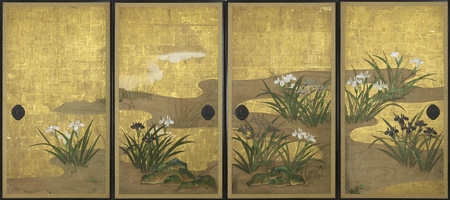Product Description
7721 A set of four fusuma (sliding doors) painted in ink and colour with purple and white kakitsubata (iris) in a stream amongst golden clouds
Japan, 18th century, Edo period
Dimensions: H. 174.5cm x W. 387cm (68¾” x 152½”)
Kakitsubata (iris) has long been used as a design motif and is praised in Japanese literature for its beauty. In art its appearance can allude to the Tale of Yatsuhashi (lit. Eight Bridges) made famous in episode 9 of Ise Monogatari (Tales of Ise). In this scene the hero who is often identified as Ariwara no Narihira (825-880) composes a poem while admiring the blooms.
‘Back then there was this man. Disgusted by his life, he decided not to stay in the Capital but set out instead for the East, to find a province to live in. One or two old friends went with him. None of them knew the way, and they often got lost. They came to a place called Yatsuhashi in the province of Mikawa. The name described the way the river fanned out there, into eight streams with a bridge over each one. Under a tree beside the marsh they dismounted and ate some parched rice. The marsh was full of irises in magnificent bloom. The sight moved a companion to say, “Make a poem about our journey, with one of the five syllables of ka-ki-tsu-ba-ta at the end of each line. So he did:
KArakoromo
KItsutsu narenishi
TSUma shi areba
HAru-baru kinuru
TAbi wo shi zo omofu
Robe from far Cathay (China)
Long and comfortably worn
Bound by love to stay
I cover these distances
Shrouded in melancholy.
At this, they wept onto their parched rice till it got all wet.’
(Tales of Ise, excerpt from episode 9, translated by Joshua Mostow and Royall Tyler)
A pair of screens with iris inspired by the above tale and painted by Ogata Korin (1658-1716) are designated as a National Treasure and housed in the Nezu Museum in Japan. See; Nezu Institute of Fine Arts ed., Catalogue of Selected Masterpieces from the Nezu Collections, Painting and Calligraphy, (Tokyo, 2001). p. 198-200, pl. 164.
For other examples of this subject in the collection of The Cleveland Museum of Art both with and without bridges see: Unfolding Beauty, p.40, pl.17, and in the collection of The Metropolitan Museum of Art, New York see: Masterpieces of Japanese Screen Painting, p.65, 67, 68, 69 and 70.






